 Is this what staff means by an “engagement charter”? By Pepper Parr
John Boich, one of the co-chairs of the Shape Burlington committee, was a very strong advocate of an Engagement Charter for the city of Burlington and while there wasn’t a very clear definition of just what an Engagement Charter was, there was no doubt in John’s mind what it meant – engage the people, John would almost shout, “involve them and tell them what the hell going on”. That’s John Boich. And the following is the document that will get taken to the Budget and Corporate Services Committee for discussion.
Working paper on ‘Burlington Engagement Charter’
Purpose
- Provide a framework for the City of Burlington to support planned and consistent approaches to public involvement.
- Inspire meaningful dialogue and informed participation about City of Burlington priorities and services.
- Enhance the City of Burlington’s commitment to inform citizens and respond to their ideas and contributions so that Burlington remains a great community in which to live, work and play.
Values
- Clear communication
- Transparency and trust
- Inclusion and demographic diversity
- Informed decision making
- Continuous improvement
Key Principles
- Careful planning and preparation
Engaging people around the issues that affect their lives is a key component of a strong democratic society. Public involvement encourages action, personal responsibility, and has a positive impact on decision making.
- Shared purpose
Support and encourage individuals, groups, government and others to work together to advance the common good. There must be a reasonable balance between the city’s legislated professional responsibilities and meaningful public involvement. The shared purpose is community building in Burlington.
- Openness
Help all involved listen to each other, explore new ideas, learn. Diverse groups of people discussing information from a variety of viewpoints can lead to better, more creative decisions. Face to face and online dialogue provide ways for citizens, staff and council to share timely information and discuss ideas and options.2)
 Public is a general and inclusive term that includes individuals, not-for-profit and corporate organizations, and institutions. Public is a general and inclusive term that includes individuals, not-for-profit and corporate organizations, and institutions.
Involvement represents the range of ways that the public can expect to participate in decision making with the City of Burlington.
Burlington’s Continuum of Public Involvement
| City of Burlington |
Inform |
Consult |
Involve/Collaborate |
Empower |
| Public Involvement Goal |
To provide information to assist the public in understanding the topic, options, opportunities, solutions and/or decisions |
To obtain public feedback on analysis, alternatives and/or recommendations |
To work directly with the public throughout the process including developing options and identifying the preferred direction |
To place final decision-making in the hands of the public |
| Promise |
We will keep you informedWe will provide timely and reliable information that is easy to find and understand |
We will keep you informed, listen to and acknowledge input, and provide feedback about how public input influenced the outcome |
We will work with you to ensure your input is understood, reflected in the options developed and will look to you for advice. We will include your input and advice into the outcome to the maximum extent possible. |
We will implement what you decide |
| Examples |
- www.burlington.ca
- Fact sheet
- Open house
- City Talk
- Education session
- Advertising
- Twitter
|
- Survey
- Electronic opinion gathering
- Public meetingInterview
|
- Focus group
- Burlington Accessibility Advisory Committee
|
- Referendum question
- Committee of Adjustment
|
More detailed information outlines “Use When” and “Don’t Use When” information.
Measuring and Monitoring Success
Section to be developed: involve/collaborate
Reporting
Section to be developed: involve/collaborate.
[retweet]

By Pepper Parr
 On the move. Watch for the moving sale.
On the move. Watch for the moving sale.
BURLINGTON, ON March 4, 2011 – It is going to be the sale of the century when Ikea prepares to move from its current location on Plains Road in Aldershot country to a new location on the North Service Road just west of Walker’s Line on a 25 acre parcel of land.
The hope is to have shovels in the ground in by the end of the year and hold the opening sometime in 2013. Before the Pier opens?
Ikea has outgrown its current location and has submitted an application to the city along with plans that will see a new retail store, warehouse and the Canadian corporate heads office at the new site which is currently an empty field.
The new set up will be 70% bigger than the old one which hopefully means a larger cafeteria and less wait for great value meals.
On the upside from an economic perspective is the 437 jobs that will be retained plus 108 new jobs. The move will preserve the corporate headquarters in Burlington and give IKEA great QEW visibility. So don’t expect much in the way of opposition from either the planning department or council when the application to change the zoning and make a change to the Official Plan.
The Burlington location is one of five IKEA stores in Ontario and, according to Tourism Burlington, the store is the #1 tourist attraction in Halton. I find that kind of hard to believe – but if you count shopping as a tourist attraction they might be right.
The new location is going to be massive: 428,500 square feet. The development is estimated to come in at $60 million.
The existing IKEA store is in Ward 1 where Rick Craven rules the roost. He said: “It is with mixed feelings that I must advise you that IKEA has submitted a development application to the City which would result in the store’s relocation from Aldershot to a site in east Burlington, at 3455 North Service Road. Been a tough period of time for Craven. He wasn’t able to get the Tiger Cats into Aldershot and now he’s losing his biggest retail operation. Craven assures the city that the IKEA location is an excellent place to do business and he is hoping that the Burlington Economic Development Corporation(BEDC) will find a rabbit in a hat somewhere and recruit a new store or office to the Aldershot site.
The new location will not tie IKEA all that tightly to any one community which is unfortunate because they have been good corporate citizens and contributed significantly to the welfare of the Aldershot community. Their moving will not be a shot in the arm to the Aldershot BIA.
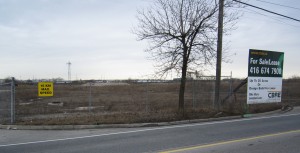 What is now an empty field on North Service Road just west of Walkers Line is to be the new home for a $60 million 428,500 sq ft IKEA facility to open in 2013
What is now an empty field on North Service Road just west of Walkers Line is to be the new home for a $60 million 428,500 sq ft IKEA facility to open in 2013
IKEA hopes to have started construction by the end of this year and open the new facility in 2013. Gosh – IKEA will be open and operational – think we can have the Pier open the same week.
The bureaucrats said their usual. Mark Gregory Chair of the BEDC opined that “The expansion of IKEA at this Burlington site is vitally important to our city’s economy. We urge City Council and staff to give serious consideration to their proposal and assure IKEA’s future in our community”. Gregory went on to say” IKEA is one of Burlington’s top employers. It has a major impact on our local economy. In addition, their presence in the city anchors the civic efforts to promote the city as a competitive head-office location with attractive amenities including ‘big city’ retailers such as IKEA.”
Kyle Benham, Executive Director of the BEDC pointed out that IKEA creates the type of jobs that are “a great fit with the growth objectives contained in our economic development strategy.” Benham is also thanking his lucky stars that IKEA didn’t look elsewhere for a new location. They would have been a great catch for any number of communities along the 401 or the QEW.
Make a note on your calendar – sometime in 2013 – great sale at IKEA – but don’t wait till then to shop.
[retweet]

The Burlington Performing Arts Centre will appear before a Council committee next week and detail their budget projections for the next fiscal year and explain their business plan for the next few years as well.
The BPAC, a project that is the pride of many in the city or one of those “nice to have but not necessary” for others, depending on which side of the cultural divide you have chosen to sit on, is getting close to Opening Day. The staffing compliment is growing as they get ready to market and promote programs for the fall season and at the same time keep public anticipation as high as possible.
 This is the look the Performing Arts Centre wants to take to the community in its branding, advertising and promotional material.
This is the look the Performing Arts Centre wants to take to the community in its branding, advertising and promotional material.
As part of the pre-launch process the centre released a new “brand” that will be used in all its marketing initiatives. Graphics are thing you either like or don’t like – here is what the Centre is going forward with.
Past chair Keith Strong has explained that the Centre is going to go for what he calls a “soft opening’ which will have the community able to tour the building and get a sense of what has been built and showcase the opportunities and the potential.
 Almost a little too much resemblance between the Mental Health Association logo and that chosen by the Performing Arts Centre. Is there a hidden intention here?
Almost a little too much resemblance between the Mental Health Association logo and that chosen by the Performing Arts Centre. Is there a hidden intention here?
The decision was made not to open with a loud, expensive boffo event but to let the community warm up to the space with events that are low key and not all that expensive.
The 12 member Board for the Centre (with the Mayor as an Ex officio member) is in place and is made up of:
[box type=”shadow”]
Chairman Allan Pearson
Allan was born in Hamilton and has lived in Burlington for most of his life, having grown up in the downtown core. He has been in the automobile business since 1976 and is President of Discovery Ford Sales in Burlington.
Allan has served on the Ford of Canada Roundtable, is a former Board member and past Chair of the Board at Wellington Square United Church and currently sits on the Board of Trustees. Allan is a past Board member and Board Chair of the Burlington Community Foundation. He is current Vice-Chair of the Canadian Ford Dealer Pension Board of Trustees, and sits on the Board of Directors for the Carpenter Hospice. Allan has completed the DeGroote School of Business/United Way not-for-profit governance workshop.
Vice Chair Rick Burgess
Rick is a business lawyer based in downtown Burlington. He is an Instructor-Business and Labour Law, Niagara and Sheridan Colleges; Mediator & Group Facilitator; Instructor-Negotiation / Mediation / Dispute Resolution. From 1980 to 1989 Rick was a business lawyer in Toronto. He has been a member of Ontario & California bar associations since 1980.
Rick’s community involvement includes:
- Past Chair, Burlington Community Foundation Board (2009-2010)
- Past Vice-Chair and Member, Halton Regional Police Services Board (2005-2010)
- Past Chair, Burlington Chamber of Commerce
- Past President, Creative Burlington (2008-2009)
- Past President, Burlington Art Centre (2002-2004)
- Burlington Art Centre Foundation Board (2004-2005)
Rick has lived in Burlington since 1992 with his wife, Brenda Bowlby, who is also a lawyer, and their daughter Lindsay, who attends university.
Keith Strong
Keith has resided in Burlington for the last 42 years. He moved to Burlington as an employee of Windsor Salt which later resulted in being employed by Metasurf Canada. In 1970 Keith purchased a small mobile wash in Hamilton and has been self employed from that time. In 1985 Keith designed and built the first totally enclosed hazardous waste transfer site and instituted the first permanent household hazardous waste location in Ontario. In the late 80’s Keith sold his business to Laidlaw. Over the last 15 years Keith has helped small business to grow and expand. The remaining of his time has been spent giving back to the Burlington community. Keith has a daughter Terra and a son Scott both married, living in Oakville raising their families.
Philippe Pango
Dr. Philippe Pango’s inventions and technologies have been successfully implemented in millions of wireless Bluetooth headsets, hearing-aids and ground penetrating radars throughout the world. A long time resident of Burlington, Dr. Pango’s career started as a Senior Design Engineer for Gennum Corporation, where he was instrumental in the company’s transition to digital hearing aid technology. In 2006 he launched his first start up, CAYCe, in partnership with McMaster University. Dr. Pango is currently the Chief Technology Officer of Vitasound Audio Inc., where he oversees the research and development of advanced audio processing technologies, including hearing aids and hearing protection devices. An avid musician, Dr. Pango understands the importance of arts in a perfectly balanced life, and its positive impact on a community. He plays electric and acoustic guitar, five-string bass, piano, organ, djembé percussion, sings in a choir that promotes the African culture throughout the Halton region, has authored two novels, and claims to be unbeatable at tennis.
Mary-Ellen Heiman
Mary-Ellen’s professional background includes skills in building strong relationship amongst volunteers, staff, major donors and business partners. She has held positions in the direction of the performing arts sector as Chair of the Board, and board member, for the St. Lawrence Performing Arts Centre in Toronto, with direct reporting to the City of Toronto. She has also been a consultant to various music, drama and heritage organizations. Mary-Ellen has also worked in the visual arts sector as Executive Director of a public non-profit art gallery. Through these roles she has distinguished herself as a strategic planner and partnership builder with strong Board of Joseph Brant Hospital.
Presently, Mary-Ellen is the Director of Development and funding for the Canadian Centre of Emergency Preparedness. In her previous consulting career, she was a consultant in needs analysis, strategic planning, promotional enhancement, program design and board development. Mary-Ellen’s skills include partnership building, workflow analysis, communication methodology and organizational change, with direct experience in marketing, governance, sponsorship and grant funding, financial and event management. Mary-Ellen has completed the DeGroote School of Business/United Way not-for-profit governance workshop.
Dominic Mercuri
Dominic is a leader in financial services marketing and is currently the Executive Vice President and Chief Marketing Officer for TD Bank Financial Group. In this capacity Dominic leads a global marketing team and is responsible for the bank’s overall market positioning, and oversees the development and execution of TD’s global marketing and brand strategy. Dominic, his wife Carol, and their children Jennifer and Frank have lived in Burlington since 1995. He is also a member of the Joseph Brant Memorial Hospital Foundation Board.
Ed Hannah
Ed Hannah was born in Collingwood, raised in Hamilton and has lived for the past 18 years in Burlington. Ed is a graduate of Yale University (B.A.); York University (M.B.A.); Osgoode Hall Law School (LL.B.); and Harvard Law School (LL. M.).
Ed has spent 22 years of his 27-year professional career as a lawyer at Davies Ward Phillips & Vineberg, LLP (Toronto) where he currently practices law, specializing in Corporate/Commercial Law, Mergers and Acquisitions, Structured Finance and Corporate Governance.
Ed has also been a Senior Vice-President of Score Media Inc., a Toronto Stock Exchange-listed public company, and Executive Vice-President, Corporate Development and General Counsel for Magna Entertainment Corp. and its parent corporation, MI Developments Inc., both public companies cross-listed on U.S. and Canadian stock exchanges. Ed has served on several public company and charitable boards of directors.
Ilene Elkaim
Ilene Elkaim, a Burlington resident since 1994, recognized for a distinguished career in Logistics and Information Systems for Retail Administration and Operations, founded Six Dynamix in 2005. Six Dynamix partners with small to mid-sized retail or wholesale organizations enabling them to improve efficiencies in their business processes. She has developed an effective process of working collaboratively with their clients to optimize administration and operations during all economic times, including software selection and implementation.
Ilene is also an active thespian within the Hamilton/Halton area since 1996. Her involvement includes acting, back stage activities as well as having been an active participant on various Boards, including The Aldershot Players and Performing Arts Burlington (now known as Creative Burlington).
Ilene looks forward to joining forces with her fellow board members and management to make constructive, progressive contributions for the Burlington Theatre Board Inc.
Mayor Rick Goldring (Ex-officio)
On December 1, 2010 Rick Goldring was sworn into office as the City of Burlington’s 28th Mayor, after serving four years as Ward 5 City & Regional Councillor. A lifelong Burlington resident, Rick went to Nelson High School and earned his BA (Economics) from McMaster. He lives here with his wife, Cheryl, and they have a combined total of seven daughters.
Having been in business locally for 30 years, most recently as a senior financial advisor with Assante Financial Management Ltd., Rick has always been actively involved in community affairs. In addition to co-hosting Taking Care of Your Future on TV Cogeco, Rick is a member and past president of the Hamilton Chapter of Advocis – Canada’s largest association of financial advisors. Rick is a Rotarian, and has also been on the Board of the Ron Edwards (Burlington) Family YMCA and the Burlington Chamber of Commerce. As City and Regional Councillor for Ward 5 in Burlington, he chaired both the Budget and Strategic Planning and the Community Services Committees.
Rick is passionate about his community and plans to address major concerns during his term including sustainable development, environmental issues and fiscal responsibility.
Peter Ashmore
Peter Ashmore has lived in Burlington for over 20 years with his wife Marla and their two children both who are now attending university. He is a principal in MLA Enterprises Inc. an investment holding company. Peter is a member of the Burlington Theatre Board and Chair of its Finance Committee. He has been involved with the Fundraising Campaign Cabinet for The Burlington Performing Arts Centre and the Performing Arts Centre Board Development Task Force. Peter is currently President of the HoliMont Ski Club: a 1400 member not for profit club located in Ellicottville, New York. He has served on the Joseph Brant Memorial Hospital Foundation Board where he held the position of Treasurer. He was also active in the development of the Triathlon Club of Burlington were he remains as director.
Denise Walker
Denise Walker has been an entrepreneur for the past twenty-five years. She started High-Q Computer Education where she taught various software applications to small businesses. Her business has evolved into doing contract work, which includes event planning, client appreciation, business data analysis and marketing support. She is currently working at Lakeshore Clinic and CIBC Wood Gundy in Burlington. Denise started as a member of the Burlington Performing Arts Centre Fundraising Campaign Cabinet for more than 5 years, and is now a member of the Burlington Theatre Board Inc. Denise is also currently the Fundraising Chair.
Denise is passionate about the project and is currently working on completing the 11 million dollar Capital Campaign.
Denise is a Wilfrid Laurier Graduate with a degree in Economics.
She was born in Montreal, but has been a Burlington resident for 41 years. Denise and her husband Kevin have three children; one doing postgraduate studies and two in university. Denise has completed the DeGroote School of Business/United Way not-for-profit governance workshop.
Steve Zorbas
Steve Zorbas is currently Acting General Manager of Development and Infrastructure for the City of Burlington, Ontario, Canada. At the City of Burlington he has also held the positions of Acting Director of the Parks and Recreation Department and Executive Director of the Finance Department. He has over 27 years financial experience within local government, which have included the Town of Richmond Hill and the City of Mississauga. Prior to entering local government he also worked in the private sector in various financial positions in both the retail and manufacturing environments.
His academic accomplishments include holding a Bachelor of Commerce degree, diploma in public administration as well as being a professional accountant, Certified Management Accountant (CMA). He currently is a board member (MPAC) at the Municipal Property Assessment Corporation and also Chair of the MPAC Audit Committee.
He has served as Chair/Past-Chair/Vice-Chair as well as board member for the Municipal Finance Officer’s Association of Ontario (MFOA). In addition he has been a board member on the Government Finance Officer’s Association of the United States and Canada (GFOA) subcommittee, Committee of Canadian Issues (CCI) as well as serving as a budget review officer and budget program advisor as part of GFOA’s distinguished budget award program.
Councillor Rick Craven
Rick Craven is a four term member of both Burlington City and Halton Regional Councils. He is a recipient of the Lyn Benson Memorial Award for outstanding contributions to the Community of Aldershot and the Halton Award of Excellence for promoting a safe and Healthy Community.
Councillor Craven currently serves on Halton’s Health and Social Services Committee, Halton Police Services Board and is President of the Halton Community Housing Corporation.[/box]
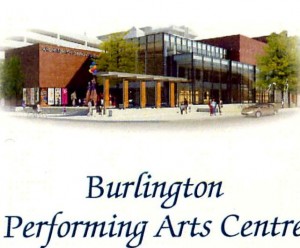 The Performing Arts Centre is getting to the point where it will soon actually look like the architects rendering we have seen for so many years. Delightful.
The Performing Arts Centre is getting to the point where it will soon actually look like the architects rendering we have seen for so many years. Delightful.
These are the people you want to button hole and share your views on the Centre and its programming. Most are volunteers and have gotten the Centre to the point where it will soon open and in the process have raised just under $11 million in public funding. The Centre is owned by the city and run by the arms length Burlington Performing Arts Centre with the city picking up any deficits while the centre gets itself on its feet.
The creation of an audience and the development of a program that meets the interest of the community is part marketing science with a lot of creativity and sensitivity to the community added. Executive Director Brenda Heatherington came to Burlington from St. Albert, a community just north of Edmonton. Alberta where she was hugely successful developing local theatre.
[retweet]

By Pepper Parr
It was an emotional event. City Council decided to recognize the community contribution made by John Boich, co-chair of the Shape Burlington report.

Boich’s 1956 Shredded Wheat football card.
John Boich, who spent most of his career in the field of education after a couple of years playing football for the Ottawa Rough Riders, also happens to have a football card that was sold recently on eBay. John was immensely amused by that sale.
He covered a lot of ground in a life that has been filled with activity and citizen engagement. The issue with perhaps the highest profile is of course the Shape Burlington report, produced by a committee that was co-chaired by John and former Burlington mayor Walter Mulkewich. That report is still reverberating around city hall where, later this month, staff will produce their response to the document that has the potential to re-shape the way citizens interact with their elected officials and the staff hired to look after the city on their behalf.

doing what he does so very well.
John has always been an intervener. On the football field, within educational organizations, at the community level and in his relationships with those who were not as fortunate as he has been, John has been generous.
He is a large man and a large personality and there is never any doubt that he is in the room. His involvement with local politics is close to legendary and if there was a shift in the thinking of a political party John had no problem moving his political allegiance.
But he never shifted away from the interests of the community and this evening the city he loves and cherishes met in a formal city council session and recognized the contribution he has made to the city of Burlington.
John is not well. He has pancreatic cancer and faces this extremely difficult stage in life with the courage and determination he has faced most of his challenges.
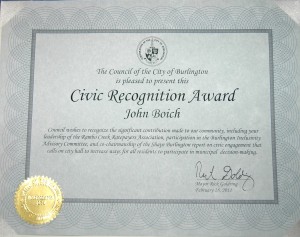 His indomitable spirit got him to City Hall where he sat in a front row with Arlene, his wife of 30 years and received from the Mayor on behalf of the City, a Medal of Merit. Long, sustained applause that no one wanted to hear end followed the prtesentation. The Council chamber had almost as many people in it as there were at the Inaugural session. After the presentation of the certificate every member of Council came forward to congratulate John Boich and wish him their very best. His indomitable spirit got him to City Hall where he sat in a front row with Arlene, his wife of 30 years and received from the Mayor on behalf of the City, a Medal of Merit. Long, sustained applause that no one wanted to hear end followed the prtesentation. The Council chamber had almost as many people in it as there were at the Inaugural session. After the presentation of the certificate every member of Council came forward to congratulate John Boich and wish him their very best.
The only ones not in attendance were John’s three Shiatsu dogs, Buster, Molly and Winston. The event was televised live on Cogeco Cable. Arlene Miller said a few words about the many, many meetings that took place in her dining room and she closed with the comment that rang true for every one in the chamber: “John was doing what he loved”.
[retweet]

By Pepper Parr with content from CNET
In the late 1950s and early 1960s, more than 10,000 children in 46 countries were born with deformities as a consequence of thalidomide use. Thalidomide was sold in a number of countries 1957 until 1961 when it was withdrawn from the market after being found to be a cause of birth defects in what has been called “one of the biggest medical tragedies of modern times”.
Medical science has done a lot for us.. Penicillin, the polio vaccine, heart transplants – the list is endless but mistakes get made and we do need to be mindful and pay attention to the technology. Ask questions now because in the past we rushed to get a new medicine and new products to market. Have we done that with cell phones?
Thalidomide was introduced as a sedative drug and was found to act as an effective tranquilizer and painkiller and was proclaimed a “wonder drug” for insomnia, coughs, colds and headaches. It was also found to be an effective inhibitor on morning sickness, and so thousands of pregnant women took the drug to relieve their symptoms.
In the United Kingdom the drug was licensed in 1958 and, of the approximately 2000 babies born with defects, 466 survived. The drug was withdrawn in 1961 and in 1968, after a long campaign by The Sunday Times newspaper, a compensation settlement for the UK victims was reached with Distillers Company Limited.
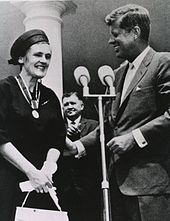 1962: FDA inspector Frances Oldham Kelsey receives an award from President John F. Kennedy for blocking sale of thalidomide in the United States.
1962: FDA inspector Frances Oldham Kelsey receives an award from President John F. Kennedy for blocking sale of thalidomide in the United States.
The impact in the United States was minimized when pharmacologist and M.D. Frances Oldham Kelsey refused Food and Drug Administration (FDA) approval. Canada was the last country to stop the sales of the drug, in early 1962.
We tell you all this because there “might”, and that might needs to be stressed, be a link between that terrible thalidomide experience and the ubiquitous use of cell phones. This is not meant to be alarmist – but questions can and should be asked.
Research ‘suggests’ that cell phone use “excites” the brain.
We picked up the following from Kent German writing for CNET; lhttps://www.cnet.com/
Here are his comments and observations:
[box type=info]If you cover the wireless industry, you’re never far from the ongoing debate over whether cell phones are harmful. And the debate usually goes something like this: the scientific community produces a study that explores the issue, and then the wireless industry rushes to interpret that study to its advantage.
 Cell phones are ubiquitous – most people use them and in some countries that’s all there is.
Cell phones are ubiquitous – most people use them and in some countries that’s all there is.
Such was the case with a report published yesterday in the Journal of the American Medical Association. Researchers at the National Institutes of Health found that in healthy volunteer participants, cell phone exposure was associated with increased metabolism of glucose in the region of the brain closest to the antenna. So as CNET blogger Lance Whitney put it, the study suggested that cell phone use “excites” the brain.
Whether that increased brain activity is harmful, however, remains to be seen. The study’s authors also concluded that their findings were of “unknown clinical significance” and that more research is needed. And, not surprisingly, the Cellular Telecommunications Industry Association (CTIA), the wireless industry’s lobbying arm in Washington, D.C., highlighted the former point in a statement.
“The authors acknowledge that the results provide no information as to potential health effects of cell phones,” the statement said. “As with any study, scientific organizations will review the results of this one in the context of the significant body of research and published literature on cell phone safety that has already been amassed.”
What’s really important
So, as I said, the scientific community reports a study and the wireless industry takes the study and highlights the points that it likes the best. Yes, that’s much how the debate between science and industry has largely progressed throughout history, but it bothers me that in the process, consumers get only the information that organizations like the CTIA want them to hear.
 Is that data correct – if it is we certainly want to know more and have someone study this and not take the word of the telephone industry.
Is that data correct – if it is we certainly want to know more and have someone study this and not take the word of the telephone industry.
Absolutely, CTIA is correct to highlight that the study makes no conclusions as to whether cell phones are harmful. Yet, dwelling on that point misses the most significant aspect of the study, which is that cell phone use can affect how your brain functions, even temporarily. Proving that point alone–and I realize that this one study doesn’t “prove” anything, but it does demonstrate it–has been the focus of much of the previous research over whether cell phones were potentially harmful. Lots of other things also affect the brain–food, sex, alcohol, drugs, to name a few–but not everything pumps out electromagnetic radiation next to your brain.
Dr. Devra Davis–an epidemiologist, environmental health researcher, and founder of Environmental Health Trust–characterizes the finding as stunning. “This demonstrates that cell phone use affects brain activity,” she told CNET. “The study used real people and was as close as you can get to a biopsy on a living brain.”
Davis, who authored the 2010 book “Disconnect: The Truth about Cell Phone Radiation, What the Industry Has Done to Hide it and How to Protect Your Family,” also cautioned against making firm conclusions from the study, but she takes a forceful role in advocating for more research. “The notion that we have enough information is completely wrong,” she said.
More research
As other, and usually inconclusive, studies continue to be published, I would be skeptical of anyone arguing that the case should be closed. Even the CTIA has argued for more research, and a spokeswoman confirmed that point with me today. Yet, I see a gap between the industry group’s actions and its vow to take the issues seriously.
For example, when the San Francisco Board of Supervisors passed a law last year requiring cell phone manufacturers to display the specific absorption rate (SAR) for each handset sold, the CTIA effectively stopped playing, took its ball, and went home. Not only did it blast San Francisco in a statement, but it also decided to move its autumn trade show to San Diego to punish the city.
Some standards
I’m not a staunch defender of San Francisco’s law–indeed, there’s plenty about my city’s government that makes me roll my eyes–but the CTIA’s reaction suggested that the “are they harmful/not harmful?” debate wasn’t worth its time. Yes, there’s no proof that a lower-radiation cell phone is safer. And, yes, information about a phone’s specific absorption rate (SAR) is widely available. Yet, as long as San Francisco is not making scientific claims about cell phone use, I don’t see the problem in giving consumers information and making it available when they buy the phone.
The CTIA mainly argued that San Francisco didn’t have the authority for such legislation. That’s possible, but as with most things, it’s never about what it’s about. As it has done in response to almost every study (including the one above) the industry also fell back on the notion that all cell phones sold in the United States are safe because they conform to FCC standards for safety (a SAR of 1.6 watts per kilogram or lower is legally considered “safe”). This is unfortunate. What most consumers don’t know is that the FCC’s standards were developed in 1993 using a model of a human who was 6 feet 2 inches tall, weighed 200 pounds, and had an 11-pound head. That’s hardly a fair representation of the average adult, let alone a child (remember, also, that kids have thinner skulls and their brains are still developing). What’s more, the digital phones we use today weren’t around 18 years ago. So maybe I’m a pessimist, but perhaps we should take a look at developing new standards.
 Is this what our heads look like? Is that a good thing? Can we know that – please.
Is this what our heads look like? Is that a good thing? Can we know that – please.
I’m not a scientist, so I’m not about to interpret the findings of this or any study. But if cell phone use can really affect brain activity, then we are nowhere near laying this argument to rest. Though much of my job is devoted to helping CNET readers find the best phone, neither CNET nor I has any interest in putting our heads in the sand and guaranteeing you that cell phones are safe. To do so would be irresponsible.
Until we can determine if cell phone use can adversely affect your health through DNA mutation–and frankly, we may not be able to determine that for many years, if we ever can at all–the industry needs to take the issue seriously. Blowing off concerned parties, alarmist as they may be, doesn’t help the situation. Nor does it help to continually point to government reports and convenient studies that find that nothing is wrong.
[/box]
The same thing happened with the thalidomide debate – but the terrible results could not be ignored. Not to be alarmist – but could someone spend some time and money on this issue – it is not exactly a “no-brainer”.
[retweet]

By Pepper Parr
 BURLINGTON, ON February 22, 2011 – It is going to be a very different budget process for Burlington this time out. Several things have happened to bring about this change. First of course there is a new council which has a number of people very comfortable with numbers – something that makes staff kind of uncomfortable. BURLINGTON, ON February 22, 2011 – It is going to be a very different budget process for Burlington this time out. Several things have happened to bring about this change. First of course there is a new council which has a number of people very comfortable with numbers – something that makes staff kind of uncomfortable.
Then there is a whole new level of data available to the Council members. These are the result of a Staff Direction Council members Taylor and Dennison put forward in the previous administration. “It has been some time in coming” commented Dennison. “It means we can now look at specific programs and determine if we are getting value for money spent and if the public is making the kind of use of a program to make it worth while.”
The Kilbride community centre is an example of a facility that has a very low usage rate – should it be kept or de-commissioned? With the data council can now make decisions based on facts and not community emotions.
Every member who made a comment was very positive about the new level of data staff had presented and Rick Craven (Ward 1) spoke on behalf of John Taylor who was away, saying “John would be absolutely giddy over this kind of data”.
Dennison, who along with Taylor had been asking for this kind of data for years and with Sharman’s huge command of accounting, especially cost accounting, this Council looks as if it is going to be able to make decisions that are based on facts. How delightful.
Staff has come up with numbers and proposals that meet the proposed 2.5% tax increase for year 1 and Dennison said that while he likes the number, he “isn’t exactly thrilled with it”. Paul Sharman (Ward 5) – sometimes known as Mr. 0 – which is the budget number he wants, didn’t make any comment.
 - Kilbride Community centre – could become storage space.
The Mayor seems happy with 2.5% . Other council members made no comment on the level of increase – suggesting that this Council would not be uncomfortable with an increase of 2.5% when it became obvious that there is a significant surplus from last year that could be applied to 2011 spending. And there are some very significant savings possible as well. Sharman let is be known that he wants to see that 2010 surplus – which he felt got created as part of a mugs game staff plays with their HR budgets, made available for inclusion in the 2011 budget and thereby reducing what the taxpayer has to put up.
It was not an easy session for several staff members. They’ve not had to answer focused questions from someone who knows the inside, outside and everything in between in a financial statement. When Sharman asked the staff member who had prepared much of the data what the “volume variable denominators” were, there was a long pause before Chris Glen, ‘chief lifeguard’ who runs the Parks and Recreation department jumped in and muttered a number of words which then brought City Manager Roman Martiuk – no stranger to numbers and the verbiage that goes with them – into the ring and he sort of danced around the phrase pointing out that municipalities were not for profit organizations and didn’t do normal commercial accounting. But, the question asked – never did get answered – what were the volume variable denominators? Based on the looks on the faces of the other council member’s faces – it didn’t look as if they had a clue.
What Sharman is saying to staff` is that he knows numbers as well, if not better than they do, and they had better not try playing a numbers game with him.
 - Struggle for control of the process. Sharman asks for detail, Lancaster wants to let them manage.
What it all appears to be coming down to is that struggle between Council and staff as to who is going to make the decisions. Sharman, who did much of the talking and certainly pummeled staff on a number of occasions, wants the data Council needs to make decisions. Whereas Blair Lancaster, (Ward 6) thinks staff should be left to manage. Sharman seems to be saying staff isn’t managing all that well and Dennison went along with him with several trenchant remarks directed at Roman Martiuk.
Staff appears to want to hold very significant reserves and also have what is called “staff gapping” savings sort of tucked away. This is a neat one. When a hire is made, staff budgets for that person as if they were on staff for the full year. If a person comes in half way through the fiscal year, staff have half a year salary that goes into the surplus.
The City Manager, perhaps rightfully so, is quite risk adverse. He doesn’t want to get caught short so he ensures that there are reserves all over the place that can be fallen back on. Those reserves get created out of surpluses from any one year.
Because the budget is usually decided upon by early April and the books for the city don’t close until early March – Council really has no idea how much of a surplus could be carried forward. And thus they don’t have access to those funds as part of their planning for the year we are going into.
The question as to the reliability of the data the Council now has, as well as the assumptions under which it was gathered, concerned Sharman and City Manager Martiuk allowed that this was a learning experience for staff.
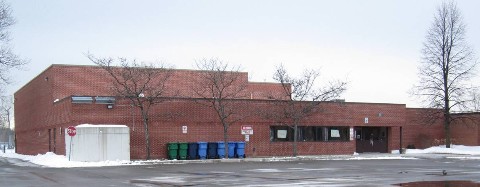 - Discovery Landing: This may prove to be a very “hard” landing
What the data tells is things like the city recovers an average of 68% 0f the cost of running an arena – but they recover 75% if there are twin ice pads and just 60% if there is just one ice pad. Pretty simple to figure that one out – two is cheaper than one. However, if the demand is not sufficient for two pads – then why undertake the capital cost of building two pads? All mundane and boring but essential if your taxes are to be kept at a level you can live with.
If the Kilbride Community Centre is de-commissioned because it isn’t being effectively used – one would want to go back and ask: Why did we build the thing in the first place?
We have a brand new fire Station ready to open on Ironside (Appleby and Upper Middle Road) but we may not have the money to pay for the 40 firefighters needed to man the place. Why did we build it? Federal Stimulus Funds were available.
Discovery Landing is getting a closer look. Marianne Meed Ward asked if the location was ever intended to break even – it certainly isn’t doing that today. They recover 57% of their costs. The location is going to show a loss of %1.32 million.
The Burlington Performing Arts Centre was budgeted to get $480,700., an understandable number given that they will not have any revenue other than what they might bring in the last two months of the year. The Centre, said to be on time and on budget, is scheduled to open in the fall. All will be revealed about the budget and the business plan for the BPAC at a meeting early in March. But there was then a request for an additional $262,800 – more than half again of the original requirement. The cost of a web site is included in this supplementary one time request. One would have thought a web site would have been included in the original budget.
That’s the world of municipal finance – surprises!
[retweet]

By Pepper Parr
BURLINGTON, ON February 17th, 2011. – They made it and in the process set a new record for the Burlington United Way campaign. The team wanted a nice round figure and so senior staff leaned a little on the Campaign Fund Raising Chair, Karmel Sakran, and got him to write a cheque for $54.00 which took the original total of $2,199,946.00 and put it over the $2,200,000. level. Nice bit above the 2010 total of $2,150,000.
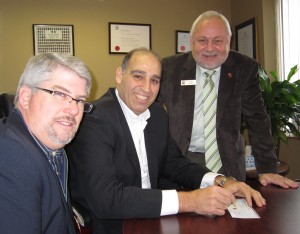 - Tim Brown, left and Len Lifchus, both of the United Way, lean just a little on Fund Raising Campaign Chair Karmel Sakran, center, to write a cheque for the amount to got the total to $2,200,00 – a record for Burlington.
Now the task of distributing the funds to the 37 different programs in Burlington that are supported by the United Way begins Len Lifchus, CEO of the joint Burlington and Greater Hamilton United Way, points out when he talks of the work the United Way does he realizes there are some serious myths about social issues in Burlington.
“People don’t think there is any poverty here – there is. People don’t think we have significant youth issues in Burlington – we have them. And people don’t appreciate how desperate some of the seniors in this community are. These are real problems and the money raised by the United Way goes a long way to helping community groups deliver a service to these people who need help”, stated Lifchus.
The task for the United Way now is to begin allocating what was raised – and that is not as simple as just writing cheques. Eighty four cents of every dollar raised get sent to the community. Seven cents is used to cover the cost of administration and nine cents used to cover fund raising expenses. As fund raising organizations go – that’s a pretty decent balance.
That 84 cents left amount to $1,848,000.00 – which will be divvied up and sent out late in March. All the organizations seeking funds have had their applications in since the end of November.
All the funding applications are reviewed by a volunteer committee that has several levels. “These applications” explained Tim Brown, Senior Director, Resource Development, “get put through several levels of review. What we watch for is the measurable outcomes that the community will see with the funds we provide.”
Volunteers are the life blood of organizations like the United Way. While there are 16 people on staff there are 554 volunteers who do things like review funding applications and make those hard choices as to who gets what. The final decision is made at the full Board level but it is the volunteers who do the grunt work and propose a schedule for the Board to approve.
“There is never enough money” cautions Lifchus. We do the best we can with what we raise and then develop the community so that more can be raised. The per capita amount raised in Burlington is $12.25 cents while in Toronto it is $56.00 but Toronto isn’t a good example to compare with – they have all those large corporations, adds Lifchus. “But adds Brown, “London is quite comparable to Burlington and their per capita is twice that of Burlington – so we have some work to do.”
The area that needs the most development is the corporate side. There are hundreds of companies in Burlington that don’t have an employee contribution program. We need to reach those companies and explain what the United Way does and how it makes a difference to the company, their work force and the community they work within.

 By Staff By Staff
July 20th, 2016
BURLINGTON, ON
How many association annual reports have you read? I mean read completely?
Pretty boring – but the things have to get put together voted on and filed.
The Burlington Foundation, which you once knew as the Burlington Community Foundation – quite why they took the word community out of their corporate name is beyond us – everything they do is community based.
The new name has an attractive corporate logo – what is really interesting is the way they set out the data points on what they have done in their annual report.
Imaginative, very visual and you know in an instant what they have done.
The work of the Foundation is broken out as funds they manage and funds they pass along to the community.
There are families in the community that have donated large sums that they want to see invested and the proceeds of the investments distributed to community groups. There are now a total of 79 funds. Most of the people who create an endowment do so in the name of a family member.
The funds are professionally managed and overseen by a Foundation Board committee.
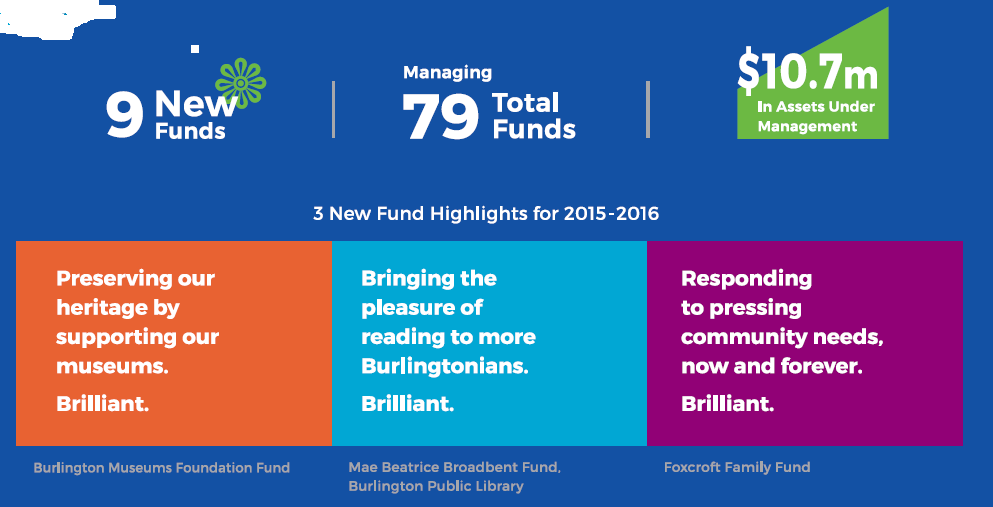
What they do with the funds they raise.
 A new endowment fund was created that will focus on Mental Wellness. It was started with a $100,000 opening gift from Dan Noonan of Argosy Securities. A new endowment fund was created that will focus on Mental Wellness. It was started with a $100,000 opening gift from Dan Noonan of Argosy Securities.
Vital Signs is the wide-ranging and in-depth report on the community and the challenges it faces now, and in the years ahead.
It is an important reference tool that focuses on the most critical areas that define the community. Built upon independent research, it is used by people, agencies and corporations to understand areas of opportunity across our city.
The comprehensive quantitative and qualitative research that goes into ongoing Vital Signs research plays a key role in enabling the Foundation to focus on granting programs that meet some of the areas of need that were uncovered.

 By Staff By Staff
April 12, 2016
BURLINGTON, ON
The Premier of Ontario Kathleen Wynne released the following statement earlier today.
I have just had a meeting with the Leader of the Green Party of Ontario to discuss election financing reform. I want to thank Mr. Schreiner for a very positive meeting to discuss these much-needed changes. He provided input, advice and feedback on the areas for reform and on the questions I asked of him — the same questions I asked the Leaders of the Official Opposition and NDP yesterday. There was much agreement between me and Mr. Schreiner on the areas for reform.
 GypTech president of Gary xxxx escorts Premier Wynne during a RibFest in Burlington. Mr. Schreiner made some specific requests that I would like to respond to directly. He said he wants to make sure the legislative committee process to consider election financial reform is open, has time to hear from witnesses across the province on the draft legislation, and allows for a full consideration of the draft legislation after both First and Second Reading.
As I said yesterday, I intend to bring forward legislation in May before the Legislature rises on June 9. With the agreement of the Legislature, we would send that legislation to Standing Committee sooner than usual, after First Reading to allow for a first opportunity to make amendments based on public input, before Second Reading. In addition, further legislative committee hearings after Second Reading will allow for another round of input and amendments.
This would allow for consultation immediately, while the Legislature is still sitting, and for further consultation during the summer, across Ontario, in agreed-upon locations. The first government witness invited to appear before the legislative committee hearings would be Ontario’s Chief Electoral Officer. In the meantime, as the legislation is being drafted, we will consult regularly with the Chief Electoral Officer.
The second government witness invited to appear before the legislative committee hearings would be Mr. Schreiner.
 Was it the smile that drew these two together? Does he have influence? In an open letter prior to today’s meeting, Mr. Schreiner asked that “big money” be taken out of politics, and asked the government to bring in comprehensive reforms that include eliminating corporate and union donations prior to the next Ontario general election. The legislation we will introduce this spring will propose a ban on corporate and union donations and I am committed that changes be in place or significantly underway before the June 2018 election.
He has also asked that the government end the practice of “selling access to Ministers of the Crown.” As I said yesterday, political donations do not buy policy decisions. Any suggestion otherwise is completely false. As Premier, I’ve always been clear that decisions made by me and my Cabinet are always made with the best interests of Ontarians in mind.
Ministers need to fundraise, just as all MPPs do, to support their work during campaigns. Ministers can do small group high-value fundraisers with two stipulations:
1. The event is publicly disclosed before it occurs.
2. The Minister is not meeting/fundraising with stakeholders of his/her ministry.
I have made the decision to immediately cancel upcoming private fundraisers that I or Ministers attend.
Future Liberal fundraisers will be made public on the OLP website.
 Premier Wynne can be very convincing. To recap, our government has already undertaken a number of initiatives to make election financing more transparent. In 2007, we introduced third-party advertising rules and real-time disclosure for political donations. Last June, I announced that we would make further changes to the Elections Act. And, as I announced last week, our government plans to introduce legislation on political donations this spring, including measures to transition away from union and corporate donations.
The legislation we will bring forward this spring will include the following:
First — reform of third-party advertising rules, including definitions, anti-collusion measures and penalties. Maximum spending limits on third-party advertising will be severely constrained for election periods and constraints considered for pre-election periods.
Second — a ban on corporate and union donations.
Third — reduction of maximum allowable donations to a figure that is in the range of what is permitted federally for each Party; to all associations, nomination contestants and candidates, as well as leadership campaigns.
Fourth — constraints on loans/loan guarantees to parties and candidates, including leadership candidates
Fifth — reform of by-election donation rules.
Sixth — overall reduction in spending limits by central parties in election periods and introduction of limits between elections.
And seventh — introduction of leadership and nomination campaign spending limits and donation rules.
To reach critical decision points associated with these issues. I have asked the following questions of all three party Leaders.
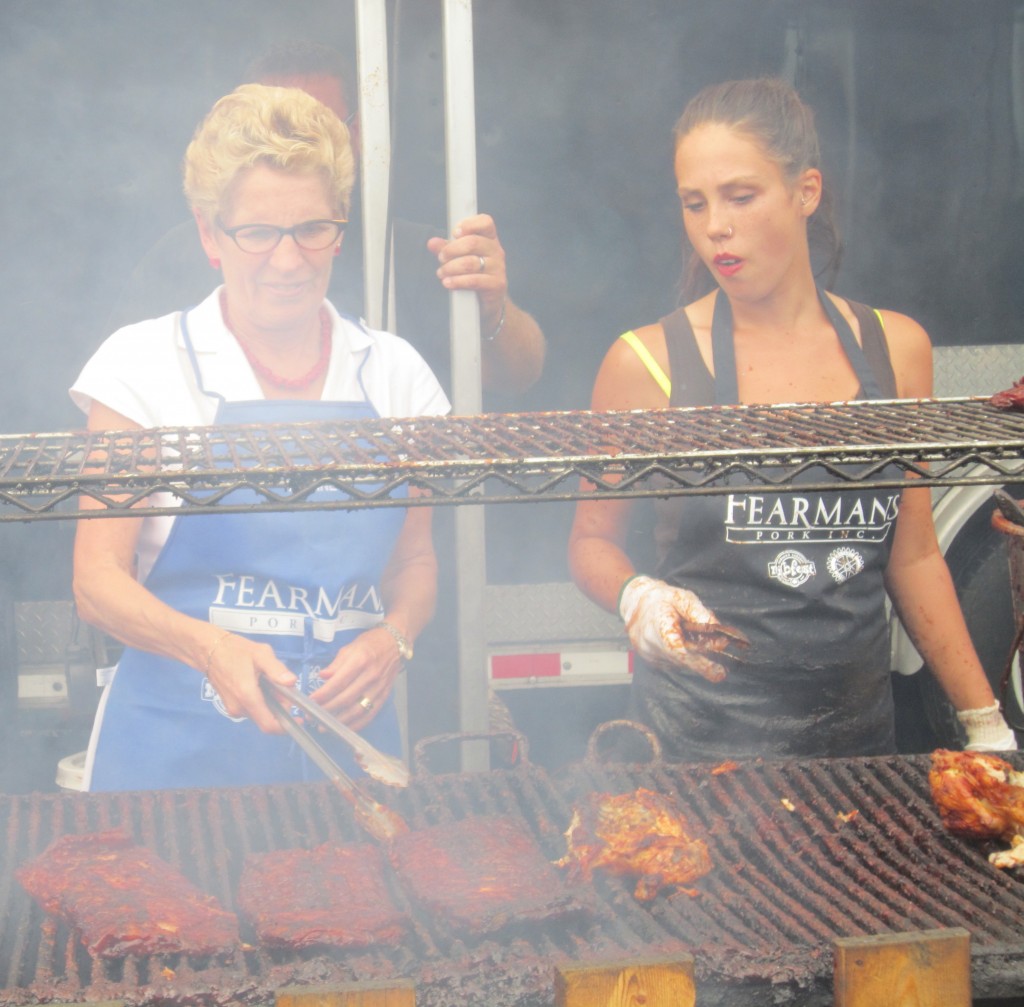 Premier Wynne has been to Burlington on a number of occasions. She learned how to flip a rack of ribs pretty quickly at RibFest. She also personally recruited current MPP Eleanor McMahon to run as the Liberal candidate in the last provincial election. • On the issue of third-party advertising, we are proposing a much lower spending limit. What should that limit be? What should the constraints on third-party advertising be between elections? Should there also be an individual contribution limit for those advertising campaigns?
• We are proposing a ban on corporate and union donations, which would begin on January 1, 2017. Should there be a transitional subsidy based on vote counts from the previous election? If so, how long should the transition period be in order to allow all parties to adjust?
• We are proposing a lower limit on donations. Should that limit be phased in over time?
• We are proposing that, during by-elections, that there be no special doubling of donations to the central party. By-election campaigns should be restricted to raising funds only to the allowable limit, both locally and centrally. What are the other Leaders’ thoughts on how we should manage any by-elections that occur before the legislation is in effect?
• We are proposing overall spending limit reductions in the writ period and setting limits between elections. We would like the Leaders’ input on this.
• We are proposing setting spending limits for leadership and nomination campaigns. What should these spending and donation limits be?
The government also intends to bring forward separate legislation this fall to amend the Elections Act, including proposals to:
• Change the fixed election date for the next general election to the spring of 2018
• Allow provisional registration of 16- and 17 year-olds
• Establish a single address authority in Ontario
• Eliminate the first blackout period for all elections, and
• Integrate, simplify and modernize a range of election processes as per the advice of the Chief Electoral Officer.
It is clear that there are flaws in the current legislation, which all parties have been operating under. The reality is that Ontario’s election financing system has not kept up with changes made federally and in some other provinces. The current system also does not meet today’s public expectations. I am determined to make changes that are right for Ontario. And I believe it is important that we now move expeditiously to make these changes.
It is important to get this right. I look forward to hearing further from all three Leaders as they consider the answers to the questions I have asked them, so that we can move quickly to bring about these needed reforms.
Ray Rivers on election funding.
The times they are a changing- the public has gotten to the point where they just plain don’t like the way the politicians climbed into bed with any special interest with a cheque book. The conflict of interest was just too blatant. The tip of that iceberg was identified by the Globe and Mail when they published a series of articles on how the politician raised the money they need to fight elections. The opposition parties didn’t make too much noise over the news reports because they too rely on corporate, union and special interest money.
But the media coverage was a little too strong to ignore – and so now the Premier has set out an aggressive set of changes that everyone is going to get a chance to have their say on. Note though that the Premier made this announcement after meeting with the Green Party – she is avoiding what the NDP and the Conservatives want to do to her neck.
Premier Wynne does deserve credit for getting in front of the parade and not getting trampled by a crowd reaction.

|
|
 Public is a general and inclusive term that includes individuals, not-for-profit and corporate organizations, and institutions.
Public is a general and inclusive term that includes individuals, not-for-profit and corporate organizations, and institutions.

































 A new endowment fund was created that will focus on Mental Wellness. It was started with a $100,000 opening gift from Dan Noonan of Argosy Securities.
A new endowment fund was created that will focus on Mental Wellness. It was started with a $100,000 opening gift from Dan Noonan of Argosy Securities.









